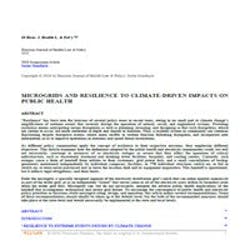Power outages have both acute and long-term impacts on public health and the critical infrastructure that supports the achievement of public health goals. Acute, immediate impacts tend to grab headlines. In November 2012, Hurricane Sandy’s storm surge knocked out power along the coast in the Northeast and Mid-Atlantic, disabling primary and backup generation at dozens of medical facilities, as well as at pump stations and wastewater treatment plants, which in turn caused the outflow of nearly 11 billion gallons of partly, or wholly, untreated sewage into waterways. Power outages caused by Sandy also disabled elevators and plumbing in high-rises, leaving elderly and medically compromised individuals stranded and unable to flush toilets or access food, heat, hot water, or medication. In September 2017, Hurricane Irma’s winds and flooding knocked out power in much of western Florida, including to hundreds of wastewater treatment facilities7 and multiple rehabilitation hospitals and nursing homes–the latter led to the death of at least ten residents in one facility where the lack of backup power meant no air conditioning for several days. Also in September 2017, Hurricane Maria destroyed most of Puerto Rico’s power lines and substations, disrupting access to critical infrastructure, facilities, and services, and led directly or indirectly to the deaths of as many as 1,000 people. Heat waves’ impacts on the electric grid and public health tend to unfold somewhat less dramatically than coastal storms, but these impacts still have bite. In addition to the notoriously fatal events of 1995 in Chicago and 2003 in France,11 other heat waves have similarly reduced the electric grid’s capacity to meet demand (“load”) at times when electrically-powered cooling equipment is most in demand, with significant adverse effects on public health.
Microgrids can improve public health outcomes by making electricity services more resilient in locations where uninterrupted access to power would avoid disruptions and damage to critical facilities and infrastructure, including but not limited to hospitals and other medical facilities,facilities where residents are in custody (such as prisons and nursing homes), wastewater treatment or drinking water purification facilities, and cooling centers, among others. But what the public health community’s conception of resilience teaches is that a microgrid is merely one technical component of the broader response to a hazard or extreme event. The value of a microgrid to public health and that microgrid’s contribution to local resilience–as defined not only by the electricity community but also the public health community–can only be fully realized if its design and development is part of a larger process. As the official in charge of implementing the NY Prize competition stated in a presentation, a basic premise of its structure is: “No Grid Resilience without Community Resilience.”
Microgrid Knowledge was granted permission to share this white paper in our white paper library.
